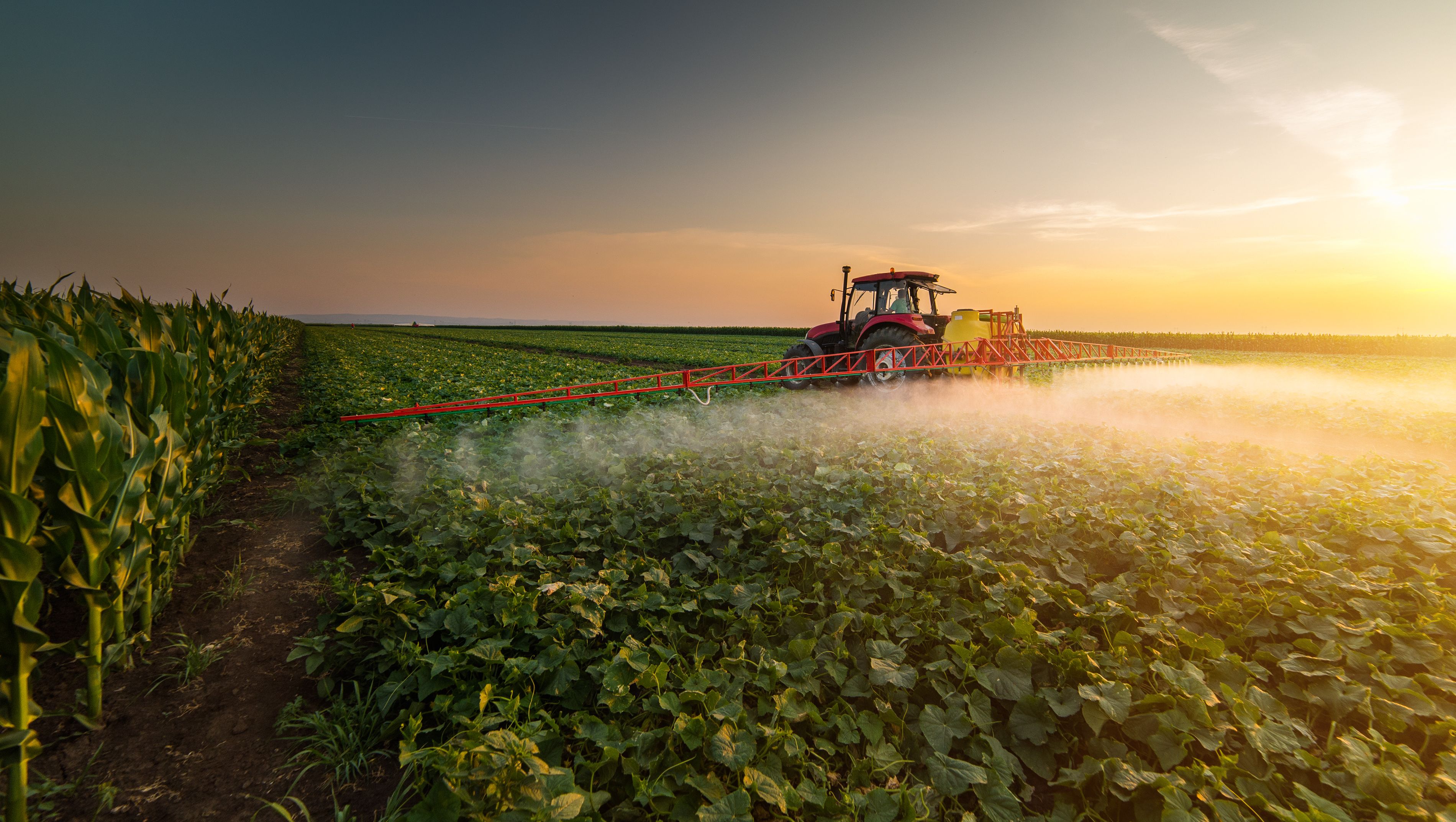Young Scientist Awardee Uses Spectrophotometry and AI for Pesticide Detection Tool
Sirish Subash is the winner of the Young Scientist Award, presented by 3M and Discovery education. His work incorporates spectrophotometry, a nondestructive method that measures the light of various wavelengths that is reflected off fruits and vegetables.
On October 16th, 2024, 3M and Discovery Education announced in a press release that ninth grader Sirish Subash as the winner of the 3M Young Scientist Challenge (1). Subash, a student at Gwinnett School of Mathematics, Science, and Technology in Georgia, developed a project called Pestiscand, which is a handheld device that could detect pesticide residues on produce using spectrophotometry (1).
Tractor spraying pesticides on vegetable field with sprayer at spring | Image Credit: © Dusan Kostic - stock.adobe.com

"Discovery Education is incredibly proud to support student innovation over the past 17 years through the 3M Young Scientist Challenge," said Amy Nakamoto, Executive Vice President of Corporate Partnerships at Discovery Education, in a press release announcing the finalists and winner (1). "It is more important than ever that future generations are given the tools needed to tackle real-world problems. Each remarkable participant has embodied the curiosity that will fuel these discoveries, and we congratulate them all."
Pesticide detection is of paramount importance in the agriculture industry. Because of threats from pests, many agricultural crops are treated with pesticides during the growing season (2). Once harvested, most of these crops still contain traces of pesticide residues on their products.
As a result, in an effort to safeguard human health, analytical techniques are needed to detect pesticide residues on crops. Surface-enhanced Raman spectroscopy (SERS), in particular, has been used as a tool for this purpose because of its sensitivity, specificity, and rapid analysis capabilities (2–4). By amplifying Raman signals through nanostructured metallic substrates, SERS enables the detection of pesticide residues at trace levels, often in the range of parts per billion (ppb) or lower (2–4).
Subash’s project employs spectrophotometry, a nondestructive method that measures the light of various wavelengths that is reflected off fruits and vegetables (1). Pestiscand also uses machine learning (ML) to analyze the spectral data, which helps determine the presence of pesticides and to what extent (1). Subash’s device contains multiple components, which include a sensor, power supply, display screen, and a processor. When his device was tested, it achieved an accuracy rate greater than 85% when detecting pesticide residues on tomatoes and spinach (1). As part of the challenge, Subash and the other finalists teamed up with a 3M scientist, who serves as a guide and collaborator to help the finalists take their innovations from concept to prototype (1). Subash was paired with Aditya Banerji, who currently serves as a Senior Research Engineer at 3M (1).
Subash becomes the 17th winner of the 3M Young Scientist Challenge. Minula Weerasekera from Beaverton, Oregon, and William Tan from Scarsdale, New York, took home second and third place, respectively, and their prizes included $2,000 (1). The fourth through tenth place winners include Ankan Das from Sanford, Florida; Steven Goodman from Lake Mary, Florida; Aakash Manaswi from Orlando, Florida; Prince Nallamothula from Frisco, Texas; Ronita Shukla from Acton, Massachusetts; Rithvik Suren from Ellington, Connecticut; and Hanna Suzuki from Bedford, Massachusetts (1).
Torie Clarke, the EVP and Chief Public Affairs Officer at 3M, said in a press release that the 10 finalists presented solutions to some of the most pressing challenges today.
"This year's Young Scientist Challenge finalists have demonstrated an incredible ability to develop creative solutions to some of the world's most pressing challenges," said Torie Clarke, EVP & chief public affairs officer at 3M (1). "I am beyond impressed and inspired by their intelligence and their scientific minds. Congratulations to this year's Top Young Scientist, Sirish Subash, and all the finalists for their phenomenal work."
References
- 3M, 14-year-old Named America's Top Young Scientist for Inventing an AI Handheld Pesticide Detector. 3M.com. Available at: https://news.3m.com/2024-10-16-14-year-old-named-Americas-Top-Young-Scientist-for-inventing-an-AI-handheld-pesticide-detector (accessed 2024-11-08).
- Wetzel, W. New SERS Imaging Technique Unveils Ultra-Sensitive Detection of Pesticide Residues in Crops. Spectroscopy. Available at: https://www.spectroscopyonline.com/view/new-sers-imaging-technique-unveils-ultra-sensitive-detection-of-pesticide-residues-in-crops (accessed 2024-11-08).
- Wetzel, W. New Method for Rapid SERS Detection of Pesticides in Agricultural Products Unveiled. Spectroscopy. Available at: https://www.spectroscopyonline.com/view/new-method-for-rapid-sers-detection-of-pesticides-in-agricultural-products-unveiled (accessed 2024-11-08).
- Wetzel, W. Revolutionary SERS Imaging Technique Enhances Pesticide Detection in Crops. Spectroscopy. Available at: https://www.spectroscopyonline.com/view/revolutionary-sers-imaging-technique-enhances-pesticide-detection-in-crops (accessed 2024-11-08).
Best of the Week: AI and IoT for Pollution Monitoring, High Speed Laser MS
April 25th 2025Top articles published this week include a preview of our upcoming content series for National Space Day, a news story about air quality monitoring, and an announcement from Metrohm about their new Midwest office.
LIBS Illuminates the Hidden Health Risks of Indoor Welding and Soldering
April 23rd 2025A new dual-spectroscopy approach reveals real-time pollution threats in indoor workspaces. Chinese researchers have pioneered the use of laser-induced breakdown spectroscopy (LIBS) and aerosol mass spectrometry to uncover and monitor harmful heavy metal and dust emissions from soldering and welding in real-time. These complementary tools offer a fast, accurate means to evaluate air quality threats in industrial and indoor environments—where people spend most of their time.
Smarter Sensors, Cleaner Earth Using AI and IoT for Pollution Monitoring
April 22nd 2025A global research team has detailed how smart sensors, artificial intelligence (AI), machine learning, and Internet of Things (IoT) technologies are transforming the detection and management of environmental pollutants. Their comprehensive review highlights how spectroscopy and sensor networks are now key tools in real-time pollution tracking.
New AI Strategy for Mycotoxin Detection in Cereal Grains
April 21st 2025Researchers from Jiangsu University and Zhejiang University of Water Resources and Electric Power have developed a transfer learning approach that significantly enhances the accuracy and adaptability of NIR spectroscopy models for detecting mycotoxins in cereals.